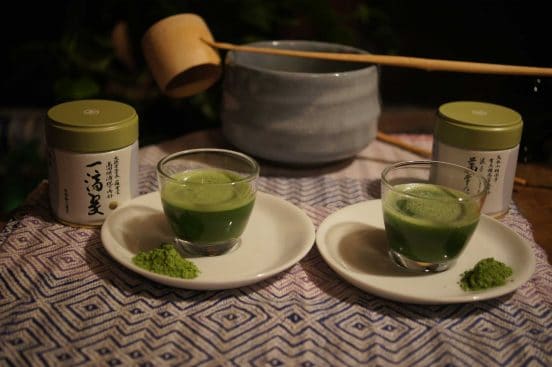Towards the end of 2018, Marukyu Koyamaen released limited editions of Ittekisui (Kin), Mannen no Midori, and Jōkō matcha. Favorites of two temple’s head priests…
These four-ish different kinds of matcha may not be available much longer, and I have only ever seen them available either from Marukyu Koyamaen directly or from Sazen Tea. Still, let me get back to “matcha lessons” with some of these matcha. They fit into my overall theme of microexploration, which I have finally begun to explain explicitly, only too nicely.
Kyoto, City of Temples
You see, Kyoto is a city of temples, and a city where the Japanese tea ceremony developed.
Unsurprisingly, matcha makers around Kyoto – certainly Marukyu Koyamaen – have a relationship with some of those temples. It is this relationship which one can get a literal taste of in the form of the Ittekisui Kin, Ittekisui, Mannen no midori and Jōkō matcha.
Ittekisui and the still-higher quality Ittekisui Kin are favorite matcha of the head master of Daitokuji temple, Myōho Takada. Here, I decided to go for the “gold” version, which is what the “Kin” in the name means and how Marukyu Koyamaen often marks their highest-quality versions of a matcha.

Ittekisui Kin Matcha
This tea can be used for koicha, the thick matcha tea (and therefore, also for usuicha, the thin matcha). It is nicely round in aroma, mellow like higher-grade matcha often are, with a tinge of sweetness and sometimes of bitterness. Interestingly, the flavor is not as deep as some highest-grade matcha’s flavor, somewhat variable, but always gentle and nice.
What makes this matcha particularly interesting, though, is the (hi)story in its background.
Daitokuji
When I went to Kyoto, I visited quite enough temples, determined to spend time effectively and just exploring. And I did not hear anything about Daitokuji.
As it turned out when I looked into the Ittekisui matcha, I should have heard about it.
Daitokuji is, simply put, the birthplace of the Japanese tea ceremony in its modern form, with lots of associations with Sen-no-rikyu… and actually, it is the name of both the main temple and the complex of temples around it, in that part of Kyoto. Daitokuji proper cannot usually be visited – but you can have the matcha which is a favorite of the temple’s head master…

Mannen no Midori Matcha
The other temple, the other tea I have tried, is the Shōkokuji temple’s chief priest’s favored matcha, Mannen no midori.
In this range of limited edition matcha, Marukyu Koyamaen also offers the Jōkō, also favored by chief priest Raitei Arima. Not least its description as robust in flavor made me personally favor the Mannen no midori, though.
Even Mannen no midori matcha is quite different from the Ittekisui Kin. It is said to be, and it is, not really bitter, but more robust and strong in flavor.
This matcha is still meant to be used for koicha. It works that way, is a pleasure to drink, but (as we have seen before with other matcha) gives a much stronger flavor in comparison that can feel like more bang for the buck – but that wouldn’t exactly be what matcha and its enjoyment is about.
It is interesting to note how similar, yet different – and different, although similar – high quality matcha end up being.
Again, this matcha also builds a bridge straight to Kyoto and its many temples. And the tea ceremony that forms a part of Zen Buddhist schools, to which many of these temples belong.
Shōkokuji
The Shōkokuji belongs to the Rinzai school of Zen; the famous Golden Pavilion and Silver Pavilion temples are also affiliated with it.
Formally known as the Mannen-zan Shōkoku Shōten Zenji – which is where the matcha’s name Mannen no midori derives from – the temple is listed among the Kyoto Gozan, the five great (Zen) temples of Kyoto.
Sounds like I know more places I would like to visit when or if I make it to Japan again. And in the meantime, I certainly have the interesting enjoyment of those matcha, which only becomes more interesting the more I learn.

Leave a Reply
You must be logged in to post a comment.